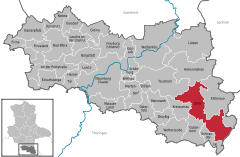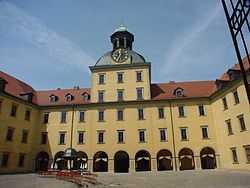Zeitz
| Zeitz | ||
|---|---|---|
|
| ||
| ||
 Zeitz | ||
Location of Zeitz within Burgenlandkreis district 
 | ||
| Coordinates: 51°2′52″N 12°8′18″E / 51.04778°N 12.13833°ECoordinates: 51°2′52″N 12°8′18″E / 51.04778°N 12.13833°E | ||
| Country | Germany | |
| State | Saxony-Anhalt | |
| District | Burgenlandkreis | |
| Government | ||
| • Mayor | Volkmar Kunze (FDP) | |
| Area | ||
| • Total | 87.15 km2 (33.65 sq mi) | |
| Population (2012-12-31)[1] | ||
| • Total | 29,639 | |
| • Density | 340/km2 (880/sq mi) | |
| Time zone | CET/CEST (UTC+1/+2) | |
| Postal codes | 06712, 06724, 06727 | |
| Dialling codes | 03441, 034423, 034426 | |
| Vehicle registration | BLK | |
| Website | German: Stadt Zeitz | |
Zeitz is a town in the Burgenlandkreis district, in Saxony-Anhalt, Germany. It is situated on the river Weiße Elster, in the triangle of the federal states Saxony-Anhalt, Thuringia and Saxony.
History
Zeitz was first recorded under the name Cici in the synode of Ravenna in 967. Between 965 and 982, it was the chief fortress of the March of Zeitz. Zeitz was a bishop's residence between 968 and 1028, when it was moved to Naumburg. Beginning at the end of the 13th century (1200s), the bishops again resided in their castle at Zeitz. The Herrmannsschacht (built in 1889) is one of the oldest brick factories in the world.
A bombing target of the Oil Campaign of World War II, the Brabag plant northeast of Zeitz used lignite coal to synthesize ersatz oil[2] – forced labor was provided by the nearby Wille subcamp of Buchenwald in Rehmsdorf and Gleina. In the middle of the 1960s work started on the "Zeitz-Ost" residential area, and in the mid-1980s, housing estates such as the "Völkerfreundschaft" (English: International Friendship) were built.
On 18 August 1976, the Protestant clergyman Oskar Brüsewitz from Rippicha burnt himself to death in front of the Michaeliskirche. This was a protest against the DDR system. The town was an industrial centre until German Reunification made many companies in eastern Germany uncompetitive. The town still has a large sugar factory.
Main sights
Zeitz sights are predominantly situated along the Romanesque Road (point 52).
- Schloss Moritzburg, a baroque-style castle with the cathedral of St. Peter and Paul. The 10th century crypt displays 17th century tin coffins including that of Moritz, Duke of Saxony.
- Michaeliskirche (1154), originally a Roman basilica and contains a 1517 original of Martin Luther's 95 Theses.
- Town Hall (1509, rebuilt in 1909). It is a Gothic structure that, together with restored houses and 3 market-places, provides Zeitz' medieval appearance.
- Herrmannsschacht, a technical monument in a former brick factory.
| Wikimedia Commons has media related to Zeitz. |
References
- ↑ "Bevölkerung der Gemeinden 31.12.2012" (PDF). Statistisches Landesamt Sachsen-Anhalt (in German). January 2014.
- ↑ Becker, Peter W. (1981). "The Role of Synthetic Fuel In World War II Germany: implications for today?". Air University Review (Maxwell AFB).
| ||||||||


